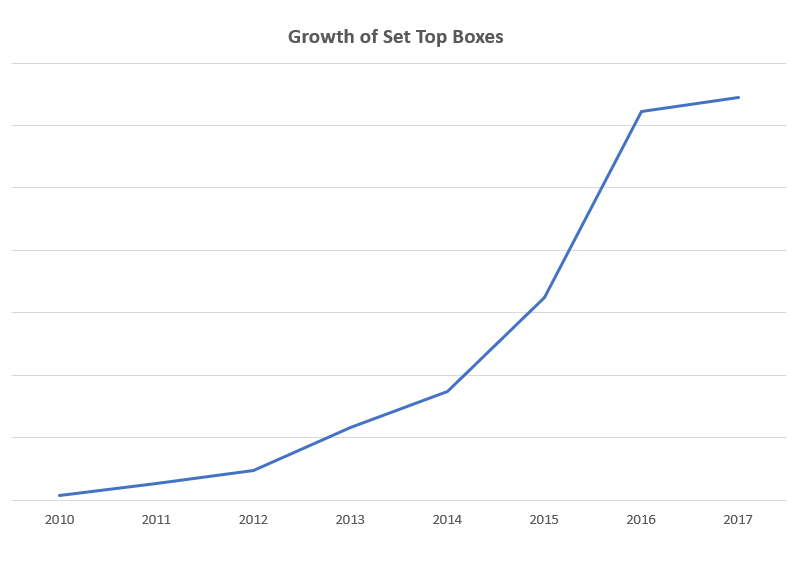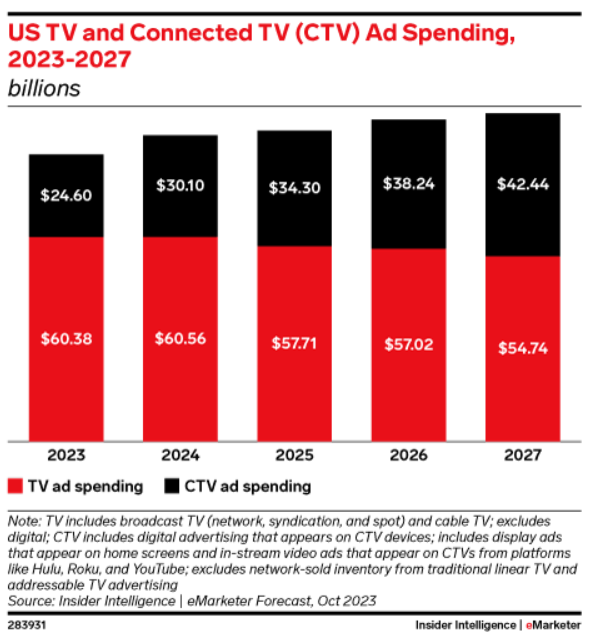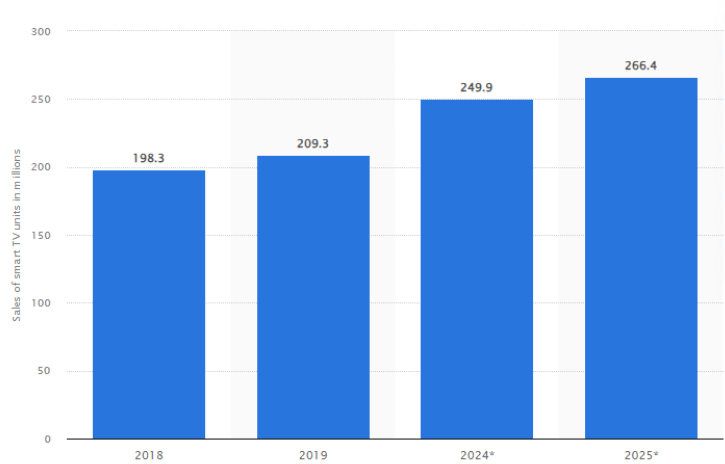
Set top box growth
The cord cutting trend during the mid 2010s resulted in a significant increase in set top box (STB) production and the introduction of several key players to a rapidly expanding market: Roku, Google (Chromecast), Apple (Apple TV), and Amazon. The introduction of affordable “TV Smart Sticks” from supermarket brands such as Aldi and Lidl also paved the way for many to make the switch.
Using DeviceAtlas data, we plotted the growth of STBs between 2010 and 2018 (around the time when production peaked):

Dumb TVs become smart
For many people, STBs were a gateway to access streaming platforms, as TVs did not have these services built in. However, since around 2018, the popularity of STBs has stalled, while smart TVs have exploded - to the point that it can actually be difficult to buy a TV without apps such as Netflix, YouTube, etc. We did a quick search on a few popular consumer electronics websites:

Now that major streaming apps are already built into TVs, the need for additional devices appears to be decreasing.
Most people who have a TV will have a smart TV, and probably don’t realize just how sophisticated it is. Automatic content recognition (ACR), essentially a fingerprinting technique, identifies what is being watched on the screen in real time. These insights can then be used for a variety of purposes: content recommendations, audience measurement, and, particularly, targeted advertising.
 Forecasted growth in CTV ad spend combined with the decline in linear TV ad spend | Source: eMarketer
Forecasted growth in CTV ad spend combined with the decline in linear TV ad spend | Source: eMarketer
Data, data, data!
At the end of the day, it really is all about the power of data and the battle to be the last device in the chain between the content source and the pixels on the screen. The device that sees the final content displayed on the screen is the one which "owns" all the data—it sees everything, regardless of whether the source of the signal is a STB, games console, etc. TVs appear to have decisively won this battle as it’s relatively cheap for them to build in apps like Netflix, etc.
Insights from ACR technology alone are hugely valuable, and arguably one of the reasons inspiring Walmart’s recent acquisition of TV manufacturer Vizio. On a side note, in 2021, Vizio published its earnings report which revealed that the company made more than double the amount of profit from its Platform Plus solution than it did from selling TVs (Platform Plus includes revenue generated from selling ad impressions as well as the viewer data sold for its InScape measurement tool).
Walmart’s acquisition of Vizio means that the retailer will have more information about viewers, allowing them to offer better targeted ads for its own products based on consumption habits. It seems that selling ads is a lot more profitable than selling bread and milk!
 Forecast of global smart TV unit sales between 2018-2025 | Source: Statista
Forecast of global smart TV unit sales between 2018-2025 | Source: Statista
Measurement impact
There are some key instances where ACR can offer more granular insights from smart TVs than STBs:
Raw video stream access
Smart TVs often have direct access to raw video streams, especially if the content is being accessed through built-in apps or services. This allows ACR systems on smart TVs to analyze the content directly from the source, potentially leading to more accurate identification and analysis.
Integration with smart TV features
Some smart TVs have dedicated ACR components that optimize performance and accuracy. Additionally, smart TVs may offer deeper integration with content recommendation systems and other smart features, allowing for more comprehensive insights into viewer behavior.
Enhanced processing power
Smart TVs typically have more powerful processors and hardware compared to most STBs. This increased processing power can enable more sophisticated ACR algorithms and faster analysis of content, leading to quicker and more accurate recognition.
Direct feedback loop
Smart TVs may provide a direct feedback loop between the ACR system and the content provider. This can enable real-time adjustments and improvements to the ACR algorithms based on user interactions and feedback, further enhancing accuracy over time.
Device intelligence of course plays a significant part in measurement as well as ACR, particularly around device graph creation, subscriber whitelist building, content optimization and monetization opportunities.

In Summary
There’s no doubt that people are still using STBs every day, but the increasing number of smart TVs flooding the market is certainly overtaking them. And with ACR becoming even more embedded into smart TV technology, we might be seeing more acquisitions of TV manufacturers in the near future. Watch this space….



